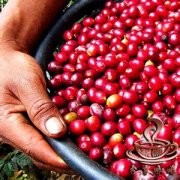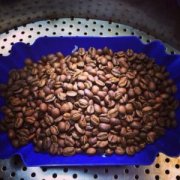A brief introduction to the planting Market Price of Fine Coffee Bean varieties with strong aroma

Bourbon coffee is a variety of small-grain coffee second only to Tibica. At first, the main branch and the trunk grew upward at 45 degrees, and drooped with fruit load, the lateral branches were denser, the fruit was more, and the yield was higher. But the berries are smaller and ripen more slowly. The top bud of Bobang is green, which is called green top coffee.
Catimor is an improved variety of Tibika. Genetic coffee with 25% Robusta is a beverage crop with high economic value. It is called the three largest beverages in the world along with cocoa and tea, and its output and consumption ranks first among the three beverages. Coffee is rich in protein, fat, sucrose, starch, glucose, caffeine and other substances, rich aroma and delicious taste. Coffee is a perennial evergreen shrub or small tree of the genus Rubiaceae. There are many species, including small seed species, medium grain species, large grain species and Ethel sa species, among which the small grain coffee species known as "fragrant coffee" have the highest yield, accounting for more than 80% of the total coffee output. Coffee originated in tropical Africa. Since the 15th century, coffee has gradually spread to all parts of the world. At present, coffee is grown in more than 70 countries and regions in the world.
Coffee cultivation in China is concentrated in Yunnan and Hainan provinces. Yunnan has a large output, with an annual output of about 26000 tons in recent years, accounting for 90 per cent of the national output. It is said that Yunnan coffee came from the French 70 or 80 years ago. The main variety is Arabica Arabica, that is, the so-called small seed coffee, commonly known as Yunnan small grain coffee. Yunnan's high-quality geographical and climatic conditions provide good conditions for coffee growth. The planting areas are Lincang, Baoshan, Simao, Xishuangbanna, Dehong and other prefectures. The natural conditions of Yunnan are very similar to those of Colombia, that is, low latitude, high altitude and large temperature difference between day and night. The small grain coffee produced by cup quality analysis is mellow, and its quality and taste is similar to that of Colombian coffee.
The separatist forces were eliminated in the Sui Dynasty, Yunnan was put back under the direct rule of the central government, and then in the early Tang Dynasty, it basically restored the scale of counties and counties in the Han and Jin dynasties. In 707 AD, the Tang Dynasty defeated the Tubo expansion forces invading Erhai Lake in the south, established iron pillars to record meritorious service, supported Nanzhao to unify Erhai area in 738 AD, and canonized Polo Pavilion as "King of Yunnan". During the Nanzhao period, the territory was bordered by Guizhou in the east, the Irrawaddy River in the west, Xishuangbanna in the south, Dadu River in the north, Vietnam in the southeast, Myanmar in the southwest, Tubo in the northwest, and Rong Zhou (present-day Yibin) in the northeast. Nanzhao internal repair system, build Dongcheng (now Kunming), build three pagodas of Chongsheng Temple.
Jin Dynasty Taishi seven years (271), changed to Ningzhou. Taikang three years (282 years), re-province into Yizhou, home Nanyi school Wei. Taian two years (303 years), reset Ningzhou. In the eighth year of Xianhe in the Eastern Jin Dynasty (AD 333), Li Xiong sent Li Shou to conquer South Central China. Li Shou was named "King of Jianning" and Qichen was the thorn history of Jiaozhou. Xiankang four years (338 years), separate Anzhou. In the fifth year of Xiankang (339 AD), Qichen descended to Jin Dynasty, and the Jin Dynasty sealed Qichen as the stabbing history of Ningzhou, and recognized its hereditary status. From then on, the powerful Yi clan ruled Yunnan for 400 years (109 BC), and Emperor Wudi opened the West and Nanyi. Yunnan is one of them. There are three ways to name the county "Yunnan". First, it is said that when the county was founded, colorful clouds appeared in Longxinghe Mountain to the north of Yunanyi Village, and the county seat was called "Yunnan" in the south of Caiyun. second, Yunshan is called "the south of Yunshan". Yunshan is (now Binchuan Chicken foot Mountain, Changningyunqi is high, and the county seat is called Yunnan in the south of Yunshan. The third is the theory of "Emperor Wu chasing Dreams". According to legend, Emperor Wu of the Han Dynasty dreamed colorful clouds at night and sent envoys to pursue dreams. He chased Caiyun in Xiangyun County today because he bought Yunan County.
Yunnan can be said to be the only province still growing Arabica on a large scale, mainly in Dehong Lincang, Baoshan, western Yunnan and Pu'er Banna in southern Yunnan. Robusta was the main coffee introduced by missionaries in the 19th century, and then it was no longer planted on a large scale. Experts assisted by the Soviet Union brought two mainstream Arabica varieties, typica and Bourbon bourbon, to Baoshan, Yunnan, for cultivation and promotion, which were well received. Later, due to the special period, scientific research and cultivation tended to stagnate. After the reform and opening up, thanks to the efforts of local agricultural experts, the iron pickup varieties cultivated by Baoshan state-run Lujiang Farm and Xincheng Youth Farm also won the first place in the international coffee competition. However, the Chinese people's understanding of coffee, so that we do not increase too much interest in growing. Since the early 1990s, in order to improve the enthusiasm of farmers, Baoshan Rezuo has introduced a Katim variety bred by the Portuguese Coffee Rust Research Center with Timor (medium grain, Tim) and Caturra (small grain, Kaddura), and has been popularized and planted with numerous titles. This variety has solved many factors such as disease and insect disasters and drought resistance, and the important thing is that the yield per mu has nearly doubled. Although it has increased the enthusiasm of farmers to grow coffee, it has also become the reason for the low quality of Yunnan coffee from now on. At the same time, Nestl é and Maxwell entered China and began to promote coffee varieties suitable for instant coffee in Pu'er and other places: S288, natural hybrid of large seed and small seed and S26 of kent hybrid of Arabica Kent in India, which had first-class rust resistance, but the planting difficulty and adaptability were low, and the cultivation was basically stopped at the beginning of the 20th century.
Speaking of which, I think there should be some judgment on the varieties of coffee in Yunnan. What about the excellent iron pickup and bourbon before? In the new promotion and planting, there are still many hills left to continue to grow old varieties of coffee, but, generally speaking, backward places do not have the protection of origin and a single species, a mountain, 10 families, all kinds of people, a gust of wind blowing, pollen flying everywhere. He he. Because of the problem of variety, Yunnan coffee really lost at the starting line.
Typica and Bourbon, two classic high-quality coffee varieties, are the main coffee varieties in Yunnan. In 1991, Katimo Catimor series varieties were introduced from Kenya (with stronger anti-virus ability and higher yield). A variety of Arabian species (also known as small seed species). Because the morphology and habits of the two varieties are similar, the two varieties are mostly mixed.
Tibica coffee, native to Ethiopia and southeastern Sudan, is the most widely cultivated variety of coffee in the Western Hemisphere. The plant is stronger, but not light-tolerant, and the yield is higher in Hawaii. The top leaf of Tibika is red and copper, which is called red top coffee.
Important Notice :
前街咖啡 FrontStreet Coffee has moved to new addredd:
FrontStreet Coffee Address: 315,Donghua East Road,GuangZhou
Tel:020 38364473
- Prev

A brief introduction to the origin, development, history and culture of excellent tin card boutique coffee beans
Tibica coffee, native to Ethiopia and southeastern Sudan, is the most widely cultivated variety of coffee in the Western Hemisphere. The plant is stronger, but not light-tolerant, and the yield is higher in Hawaii. The top leaf of Tibika is red and copper, which is called red top coffee. Bourbon coffee is a variety of small-grain coffee second only to Tibica. At first, the main branch and the trunk grew upward at 45 degrees, drooping with the fruit load, and lateral branches.
- Next

A brief introduction to the cultivation of slightly fruity tin tin card boutique coffee beans, geographical location, climate and altitude
Yunnan coffee was planted on a large scale in the mid-1950s, with a planting scale of 4000 hectares at one time. By the end of 1997, the planting area of coffee in the province had reached 7800 hectares. At present, the planting area of the province accounts for 70% of the national area, and the output accounts for 83% of the whole country. Yunnan coffee has established the dominant position in China in terms of planting area and coffee bean production. Yunnan coffee should be distinguished by planting.
Related
- Detailed explanation of Jadeite planting Land in Panamanian Jadeite Manor introduction to the grading system of Jadeite competitive bidding, Red bid, Green bid and Rose Summer
- Story of Coffee planting in Brenka region of Costa Rica Stonehenge Manor anaerobic heavy honey treatment of flavor mouth
- What's on the barrel of Blue Mountain Coffee beans?
- Can American coffee also pull flowers? How to use hot American style to pull out a good-looking pattern?
- Can you make a cold extract with coffee beans? What is the right proportion for cold-extracted coffee formula?
- Indonesian PWN Gold Mandrine Coffee Origin Features Flavor How to Chong? Mandolin coffee is American.
- A brief introduction to the flavor characteristics of Brazilian yellow bourbon coffee beans
- What is the effect of different water quality on the flavor of cold-extracted coffee? What kind of water is best for brewing coffee?
- Why do you think of Rose Summer whenever you mention Panamanian coffee?
- Introduction to the characteristics of authentic blue mountain coffee bean producing areas? What is the CIB Coffee Authority in Jamaica?

